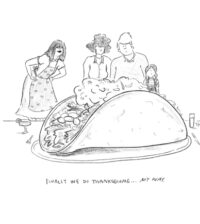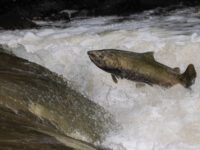How many times, during the course of a day, does a person consider the water molecule? Or that while water covers 70 percent of the earth’s surface, only one percent of that is useable – and over half of that is polluted? Or that humans are “bipedal sacs of saline solution?” Or that the health of our water is the primary measure of the health we have in the land?
Brock Dolman, biologist for the Occidental Ecology Center and guest speaker of the Sonoma Ecology Center’s Oct. 21 Water Wisdom Forum, illustrated all those concepts and more for the small, entranced audience at the Glen Ellen Church. “You can spend a lot of time deeply tripping out on water,” said Dolman. His presentation began with a poetic personification of the water molecule, proceeded with facts, statistics and illustrations and ended with practical applications. “I’m mostly trying to support people in that water is unique and critical and currently in crisis and there’s lots of things they can do in their houses, in their cities and counties and state,” Dolman said. “I’m supporting people to take some charge at some level. Daunting as it is, there’s lots of innovative things you can do.” He said it was like building a network, or a department of “homeland security.” He wanted to help people to “just become empowered.”
He connected the value and necessity and scarcity of water to the climate crisis and problem with emissions. The statistics were surprising. For example, one hour of running a gas-powered lawnmower, he said, gave off emissions equaling eight hours of driving a car. Another surprise was that every eight months, an amount of oil equal to the Exxon spills goes into our national storm drains from oil leaks from cars.
If the overall picture carried a sense of urgency and possibly dismay, the practical part of his talk sounded almost uplifting. Sonoma City Councilmember Steve Barbose said the talk made him think about what he could do in his own home. “I think he is just way out ahead in his thinking of where we all need to go. The idea that we are still treating storm water as something to get rid of – in drought, worried of long term projections, we absolutely have to be looking at storm water as a resource.”
Dolman calls it rainwater harvesting. This is an approach that reverses the typical concept that storm water is a problem and the object of traditional storm water engineering is to drain, channel and move the water quickly off the property and roads and down into storm drains. Harvesting the rainwater, as he described it, has the opposite goal: slow it, spread it, sink it. Retaining the water, allowing it to spread over land, enables the groundwater to benefit from the rain. Water catchment systems can store enough water to irrigate gardens throughout the year.
Dolman gave many examples of water retention designs, from porous concrete blocks to turf-covered roofs, to storage tanks. He showed examples of “rain gardens,” where the ground had been contoured to hold the water instead of letting it run off. Even parking lots can be re-designed to allow areas where water will seep in, not just run off. All this, he emphasized, is currently being done, and helps recharge the aquifers, which are under stress. To those wanting to know more, he mentioned a useful Web site, Treepeople.org.
The city has informed residents that people need to switch to low-flow shower heads and trade their thirsty lawns for xeriscape gardening. But to several in the audience, the news that simply switching to a front-loading washer would cut that activity’s water use in half was a revelation.
Sonoma resident Gina Cuclis said, “For me, it’s almost, like ‘Omigod, there’s so much to do!’ At least now, I’m thinking about it.” Thinking about it, she wondered what the county could do to help homeowners get started on their own conservation programs. “The issue with all this, greenhouse gasses, reusing water – the impact is not with new building; common sense will tell you the number of new houses is small compared with existing housing. So the real challenge with any of these programs is what do you do to make it adaptable for existing homeowners to make changes.”
The support of the City of Sonoma would be a place to start, suggested Barbose. “I really want the city to look at this and pursue it…It’s so obviously the right thing to do.”
Sonoma Ecology Center brings home Water Wisdom
More from What's HappeningMore posts in What's Happening »
- Cartoon by Hillary: “Finally We Do Thanksgiving…My Way”
- Permit Sonoma Recommends Decertification of the SDC Specific Plan Environmental Report and Abandoning the SDC Specific Plan
- Chinook Salmon Spotted in Valley Creeks
- Lighted Tractor Parade Set for November 30 on Sonoma Plaza
- Creative Sonoma Announces #TeachTheArts Campaign to Boost Local Teaching Workforce
- The Living Legacy of Mac McQuown






